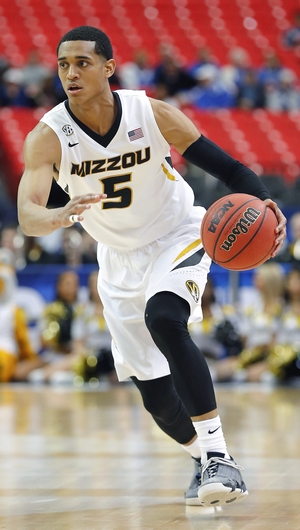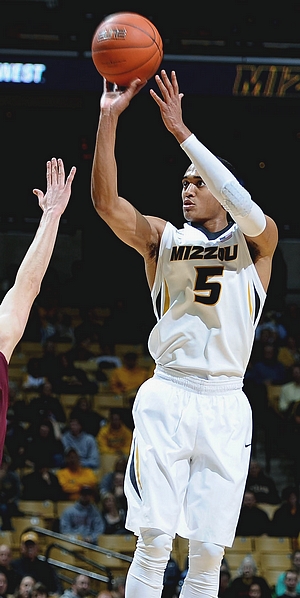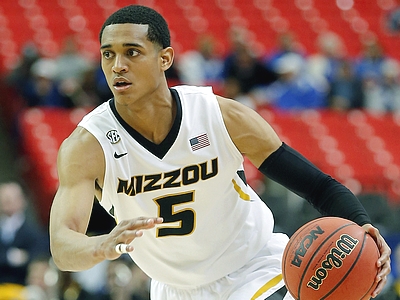Latest DX Scouting Reports:
-Devyn Marble
-DeAndre Daniels
-Spencer Dinwiddie
-Adreian Payne
-Jordan Adams
-Isaiah Austin
-LaQuinton Ross
[url=-Jabari Brown
-Jerami Grant
-James Young
-Kyle Anderson
-Patric Young
-Russ Smith
-Dwight Powell
-Gary Harris
-Lamar Patterson
-Jarnell Stokes
-Jahii Carson
-Nick Johnson
-Cleanthony Early
-P.J. Hairston
-Zach LaVine
-Artem Klimenko
-Keith Appling
-Tyler Ennis
-Markel Brown
-Jordan McRae
-Rodney Hood
-Doug McDermott
-Juvonte Reddic
-Jordan Bachynski
-Andrew Wiggins
-Elfrid Payton
-Aaron Craft
-Marcus Smart
-C.J. Wilcox
Matt Williams
Jordan Clarkson had an immediate impact for Frank Haith's Missouri program after sitting out the entire 2012-2013 season as a transfer. Averaging 17.5 points and 3.4 assists per-game, he earned All-SEC 2nd Team honors, ranking among the most productive guards in the conference.

Helping the Tigers get off to a 12-1 start, Clarkson picked off where he left off two years ago at Tulsa, where he garnered All-Conference USA 1st team honors in 2012. Despite the team's early success, and Clarkson's hot start, they struggled down the stretch, going 9-9 in-conference before losing in the second round of the NIT to Southern Miss, leading to an exodus of the team's key figures. Frank Haith opted to fill the vacant Head Coaching position at Tulsa, while his two best players, Clarkson and the team's leading scorer, Jabari Brown, declared for the 2014 NBA Draft.
Clarkson is an intriguing prospect thanks in large part to his size for a primary ball-handler and solid athleticism. Measured 6'4.5 in shoes with a 6'7.5 wingspan (in 2012), he has terrific size for a point guard to go along with good, but not spectacular, athleticism. Though his 193-pound frame still has some room for development, there's plenty to like about Clarkson from a physical perspective.
Averaging 11.5 points and 2.1 rebounds per-game as a freshman, Clarkson was a significant contributor in each of his three seasons at the college level. He took a considerable step forward as a scorer and playmaker assuming the role of first option as a sophomore at Tulsa before transferring, and while he showed improvement in some areas as a redshirt junior as Mizzou, he took a step back in some key areas as well, leaving some questions about how he'll fit in at the NBA level.
Using 28% of Missouri's possessions, Clarkson shouldered a considerable load for the Tigers offensively. Though he finished as the team's second leading scorer, he was its most important player offensively, charged with manufacturing shots for himself and others extensively on the pick and roll and in isolation situations, two things he did as frequently as almost any player in the country as the creative force behind much of what his team looked to do offensively.
A smooth athlete who is more fluid than shifty or explosive with the ball in his hands, Clarkson nonetheless showed the ability to get to the basket off the dribble in the half court at the college level. Possessing just an average first step, using his off-arm extensively to create space, and looking shaky at times trying to navigate through traffic, the redshirt junior is capable of finding seams when dribbling off ball screens or attacking one-on-one where his rangy strides and aggressiveness help him get into the paint. Though he's not a great ball-handler or an overly explosive leaper, he uses simple crossovers, spin moves, and euro-steps to find angles the rim, where he can finish with touch or use his size to get his floater off over defenders. Making 56% of his shots in finishing situations, sinking 46% of his floaters, and getting to the line 6.4 times per-40 minutes pace adjusted, Clarkson was most effective scoring around the rim and attacking the basket in transition at the college level, something that remains to be seen how it might translate against higher level competition.
Clarkson was not as prolific or effective away from the rim last season, and teams began to make a concerted effort to find ways to keep him away from the basket as they game-planned for Missouri as the season wore on. Shooting the ball with a low, somewhat awkward release point, Clarkson connected on just 25% of his catch and shoot jump shots. He was only marginally better off the dribble, making 32% of his pull-ups. With defenders not respecting his jump shot, Clarkson struggled to turn the corner and get to the rim some nights. His ability to become a reliable shooter will play a key role in his development as a pro, but there is certainly some hope as he made 37% of his jumpers as a sophomore at Tulsa in 2011-2012, playing almost exclusively off the ball.

Aside from his scoring ability, Clarkson was a bit of a mixed bag last season, as it appeared he was still learning how to play the point guard position. Pushing off frequently, dribbling his way into trouble, and leaving his feet without recourse at times, his decision-making isn't ideal, which contributed to him ranking dead last among the 15 point guards in our Top-100 prospects in both Assist to Turnover ratio and Pure Point Ratio. He does a nice job finding the open man, and will make some creative passes in drive and dish situations, but questions remain about whether he can be trusted to run a team at the next level. Missouri wasn't overly successful with him at the helm, as they were not invited to the NCAA Tournament in what was considered a weak SEC this year.
Defensively, Clarkson's size is a plus when he's closing out shooters or contesting shots inside the arc, and he puts in decent effort at times when he's fully engaged, but his lack of great lateral speed limits his ability stay in front of quicker guards. Playing quite a bit of zone last season, Missouri's defensive scheme's masked that fact effectively for stretches, and while Clarkson has the tools to be solid on this end of the floor, his limited quickness and length don't afford him great potential defensively at either guard spot.
With Clarkson's three-point shooting regressing from 37% as a sophomore to 28% this year and his two-point percentage fall from 54% over the first 15 games of the year to 47% over the last 20, the San Antonio native didn't have a tremendously efficient season as teams began to hone in on him, but he still ranked among the top scorers in the SEC. Learning that his father had been diagnosed with cancer in early February, this was not an easy season for Clarkson off the floor either. NBA teams will certainly be intrigued by his size and scoring instincts, but it will be Clarkson's ability to show promise as a point guard and jump shooter in workouts that could dictate where he lands on draft day. A candidate to hear his name called in the top half of the second round, or possibly even in the late first if a team truly falls in love with him, Clarkson is a player to keep an eye on in the draft process as some of his weaknesses are ones he could still improve on in a different setting.
Jordan Clarkson had an immediate impact for Frank Haith's Missouri program after sitting out the entire 2012-2013 season as a transfer. Averaging 17.5 points and 3.4 assists per-game, he earned All-SEC 2nd Team honors, ranking among the most productive guards in the conference.

Helping the Tigers get off to a 12-1 start, Clarkson picked off where he left off two years ago at Tulsa, where he garnered All-Conference USA 1st team honors in 2012. Despite the team's early success, and Clarkson's hot start, they struggled down the stretch, going 9-9 in-conference before losing in the second round of the NIT to Southern Miss, leading to an exodus of the team's key figures. Frank Haith opted to fill the vacant Head Coaching position at Tulsa, while his two best players, Clarkson and the team's leading scorer, Jabari Brown, declared for the 2014 NBA Draft.
Clarkson is an intriguing prospect thanks in large part to his size for a primary ball-handler and solid athleticism. Measured 6'4.5 in shoes with a 6'7.5 wingspan (in 2012), he has terrific size for a point guard to go along with good, but not spectacular, athleticism. Though his 193-pound frame still has some room for development, there's plenty to like about Clarkson from a physical perspective.
Averaging 11.5 points and 2.1 rebounds per-game as a freshman, Clarkson was a significant contributor in each of his three seasons at the college level. He took a considerable step forward as a scorer and playmaker assuming the role of first option as a sophomore at Tulsa before transferring, and while he showed improvement in some areas as a redshirt junior as Mizzou, he took a step back in some key areas as well, leaving some questions about how he'll fit in at the NBA level.
Using 28% of Missouri's possessions, Clarkson shouldered a considerable load for the Tigers offensively. Though he finished as the team's second leading scorer, he was its most important player offensively, charged with manufacturing shots for himself and others extensively on the pick and roll and in isolation situations, two things he did as frequently as almost any player in the country as the creative force behind much of what his team looked to do offensively.
A smooth athlete who is more fluid than shifty or explosive with the ball in his hands, Clarkson nonetheless showed the ability to get to the basket off the dribble in the half court at the college level. Possessing just an average first step, using his off-arm extensively to create space, and looking shaky at times trying to navigate through traffic, the redshirt junior is capable of finding seams when dribbling off ball screens or attacking one-on-one where his rangy strides and aggressiveness help him get into the paint. Though he's not a great ball-handler or an overly explosive leaper, he uses simple crossovers, spin moves, and euro-steps to find angles the rim, where he can finish with touch or use his size to get his floater off over defenders. Making 56% of his shots in finishing situations, sinking 46% of his floaters, and getting to the line 6.4 times per-40 minutes pace adjusted, Clarkson was most effective scoring around the rim and attacking the basket in transition at the college level, something that remains to be seen how it might translate against higher level competition.
Clarkson was not as prolific or effective away from the rim last season, and teams began to make a concerted effort to find ways to keep him away from the basket as they game-planned for Missouri as the season wore on. Shooting the ball with a low, somewhat awkward release point, Clarkson connected on just 25% of his catch and shoot jump shots. He was only marginally better off the dribble, making 32% of his pull-ups. With defenders not respecting his jump shot, Clarkson struggled to turn the corner and get to the rim some nights. His ability to become a reliable shooter will play a key role in his development as a pro, but there is certainly some hope as he made 37% of his jumpers as a sophomore at Tulsa in 2011-2012, playing almost exclusively off the ball.

Aside from his scoring ability, Clarkson was a bit of a mixed bag last season, as it appeared he was still learning how to play the point guard position. Pushing off frequently, dribbling his way into trouble, and leaving his feet without recourse at times, his decision-making isn't ideal, which contributed to him ranking dead last among the 15 point guards in our Top-100 prospects in both Assist to Turnover ratio and Pure Point Ratio. He does a nice job finding the open man, and will make some creative passes in drive and dish situations, but questions remain about whether he can be trusted to run a team at the next level. Missouri wasn't overly successful with him at the helm, as they were not invited to the NCAA Tournament in what was considered a weak SEC this year.
Defensively, Clarkson's size is a plus when he's closing out shooters or contesting shots inside the arc, and he puts in decent effort at times when he's fully engaged, but his lack of great lateral speed limits his ability stay in front of quicker guards. Playing quite a bit of zone last season, Missouri's defensive scheme's masked that fact effectively for stretches, and while Clarkson has the tools to be solid on this end of the floor, his limited quickness and length don't afford him great potential defensively at either guard spot.
With Clarkson's three-point shooting regressing from 37% as a sophomore to 28% this year and his two-point percentage fall from 54% over the first 15 games of the year to 47% over the last 20, the San Antonio native didn't have a tremendously efficient season as teams began to hone in on him, but he still ranked among the top scorers in the SEC. Learning that his father had been diagnosed with cancer in early February, this was not an easy season for Clarkson off the floor either. NBA teams will certainly be intrigued by his size and scoring instincts, but it will be Clarkson's ability to show promise as a point guard and jump shooter in workouts that could dictate where he lands on draft day. A candidate to hear his name called in the top half of the second round, or possibly even in the late first if a team truly falls in love with him, Clarkson is a player to keep an eye on in the draft process as some of his weaknesses are ones he could still improve on in a different setting.

























Comments